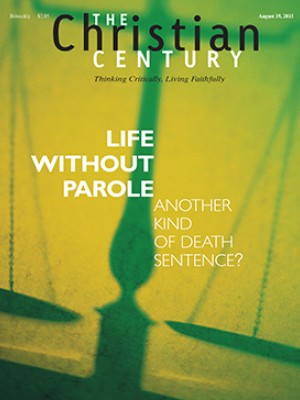Mass grave monuments in Ukraine honor Holocaust dead, reopen chapter of local history
Ludvika Sarah Leah Schein, who survived the Holocaust, hadn’t been to her hometown in 70 years. But she still vividly remembers the day Germans came to Rava-Ruska.
“We ran immediately into the forest,” Schein said, explaining how she and her two sisters narrowly escaped the Germans before a gentile family took them in. “Bullets were flying at us from all directions. It was a miracle we were not killed.”
Schein, who now lives in San Francisco and whose parents and brothers were killed by the Nazis, attended a ceremony unveiling monuments to murdered Ukrainian Jews and giving family members a place to visit and pay their respects seven decades later.
Read our latest issue or browse back issues.
The first five monuments were opened in late June in western Ukraine, giving official recognition to mass graves containing the remains of Ukrainian Jewish people murdered by German troops between 1941 and 1944.
These also mark the lifting of a Soviet-era taboo about discussing Jewish victims of the Holocaust in the official history, an about-face for Ukraine. When it was part of the Soviet Union, Ukraine tended to follow a Soviet narrative grouping together all Eastern Europeans killed by the Nazis as “victims of fascism.”
“It’s a new spirit of confronting the understanding of memory,” said Deidre Berger, head of the Berlin office of the American Jewish Committee, which worked with local groups to complete the monuments. “The Soviets suppressed this history, and only in the last 15 years have people been able to talk about it.”
The monuments erected in Rava-Ruska, Kysylyn, Ostrozhets, Prokhid, and Bakhiv—towns where, before the Holocaust, 40 to 80 percent of the residents were Jewish—sit atop mass graves containing the remains of 32,000 of the 1 million Ukrainian Jewish people murdered during the Holocaust. The Nazis also murdered 3 million Ukrainian non-Jews as part of Germany’s Lebensraum plan to eradicate Eastern Europeans and repopulate their lands with Germans.
The memorial project builds on the landmark work of French Catholic priest and Georgetown University adjunct professor Patrick Desbois, whose organization, Yahad—In Unum (which translates as Together—In One), has found more than 1,600 Jewish mass graves in Ukraine, Belarus, Russia, Poland, Romania, Moldova, and Lithuania and interviewed over 4,000 witnesses to the Holocaust.
Desbois visited Rava-Ruska’s concentration camp 25 years ago to see where his grandfather and other members of the French Resistance were held. He had read that the town also contained a mass grave for 15,000 Jews, but initially no one would take him to the gravesite.
“I knew from my research that my grandfather was deported to a Jewish village that was totally destroyed,” Desbois said. “I kept returning to Rava-Ruska and asking people to take me to the mass grave of the Jews, but people were reluctant.”
That reluctance lessened in 2004 when the local government changed and Desbois met Yaroslav Nadyak, then deputy mayor of Rava-Ruska. Nadyak encouraged locals to help Desbois document the town’s Jewish past, thereby setting in motion the decadelong research project culminating in the new monuments.
“Yaroslav brought me into the forest with 50 farmers, very old people who were present at the killing of the Jews,” Desbois said. “And they described, one by one, what happened.”
Desbois calls the Germans’ atrocities in Ukraine “a Holocaust of bullets,” since they simply shot Jews and ordered Ukrainian gentile peasants to bury them—often alive.
He said ceremonies like the one at the Rava-Ruska camp on June 29 are important for family members of victims, such as Schein, and for locals to keep alive the memory of what happened there.
“Thirteen German private trucking companies came to work in Rava-Ruska,” Desbois said. “The Nazi killers hired these German companies to move the bodies to mass graves. People must understand, Rava-Ruska was a huge killing center: first for the Jews, then for political prisoners, and then for the local population and the Roma. Each person who was killed here was an individual. We can’t forget this.”
Anatoly Podolsky, director of the Kiev-based Ukrainian Center for Holocaust Studies, said he hopes schools will integrate Ukraine’s Jewish history into their curricula.
“This can become an example for the whole country,” Podolsky said. “The Jews who lived here were not guests. They shaped the history and development of this region for over 400 years.”
Students in the five towns where the monuments were constructed used grant money to create pamphlets and permanent outdoor displays telling the stories of their towns’ Jewish histories. They, along with their teachers, also gave emotional speeches at the dedication ceremony.
A second phase of the monuments program is planned to be rolled out nationally in coming years. Many Ukrainians know that thousands of their countrymen risked their lives to hide Jews from the Germans. But the idea that Ukrainians collaborated with the Germans is still not well known nor widely accepted.
During the dedication for the monument in Bakhiv, for example, a local man in his fifties interrupted the ceremony to take issue with the wording of a memorial plaque which stated that Jewish life in the area was eradicated by “German occupiers and their local subordinate authorities.”
Most of the crowd was silent during his heckling, but then a 78-year-old Jewish woman from the town—herself a Holocaust survivor—emerged from the crowd of about 200 assembled on the hillside monument. She challenged his assertion. The two argued in Russian until rabbis from the United States and Ukraine interceded.
“It says on the sign that the locals participated with the Nazis—and it’s true,” Svetlana Pineva, the survivor, said. “My mother and I, as a three-year-old girl, we were almost killed by both Nazis and by Ukrainians. But it’s also true that my mother and I were saved by a Ukrainian family that hid us until the end of the war.” —Religion News Service
This article was edited on August 4, 2015.





